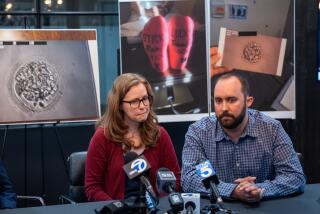Scientists map genes at work in human embryos’ earliest days
A team of scientists in Sweden has broken open the genetic recipe for a human embryo’s first three days of development, chronicling what happens in the crucial hours that follow the union of egg and sperm.
The order in which a human’s 23,000 genes awaken and start the process of building a person has never been charted before. But therein lie some momentous turning points -- moments that determine whether a fledgling embryo will grow and thrive or sputter and die, and moments at which the earliest seeds of disease can be sown.
Twenty-four hours after a single egg cell has been penetrated by a sperm cell, it will split and become a two-cell zygote. At the end of two days, there will be four cells, and by day three, there will generally be eight cells. During the three-day initiation studied in the latest effort, an embryo is technically homeless: It has not yet implanted itself on the wall of a woman’s uterus.
This unformed mass will develop into billions of highly diverse cells by the time a fetus has reached full term. Each of those cells is hatched and sent forth to perform its function on the instruction of genes that are all present at the embryo’s creation. But those genes are not all active at the creation; they are activated sequentially.
Knowing which and how many of those genes go first could unlock a host of mysteries -- not least of which is, how do two simple cells create a human?
Deconstructing the process could clarify whether some DNA long dismissed as “junk” has, in fact, a crucial function. It could make more efficient the process of turning the clock back on adult cells to create pluripotent stem cells for the treatment of diseases.
Insights from the new research could also help infertility specialists decide which 4- and 5-day-old embryos (called blastocysts) should be transferred from a petri dish into a woman’s uterus. And they may shed light on the origins of devastating genetic diseases, and how early they might be diagnosed or thwarted.
Published Thursday in the journal Nature Communications, the study found that only 32 of a typical human’s 23,000 genes are switched on two days after fertilization. By day three, 129 genes have been activated.
The study’s senior author, molecular geneticist Juha Kere of Sweden’s Karolinksa Institute, called these genes “the ignition key” that turns on human embryonic development. To chronicle their activation “is like dropping a stone into water and then watching the waves spread across the surface,” he said.
Not all of those ignition keys were familiar to genetic scientists. Seven of the 129 genes that were active in a zygote’s earliest days had not been discovered previously.
Some of those newly identified genes were found to interact with repeated DNA sequences long called “junk” because they do not hold the blueprint for the production of a protein. That observation suggests that some DNA sequences long thought to have no function at all may in fact be pivotal to getting the enterprise of fetal development off the ground. Having performed that crucial function, the research suggests, they may retire to a life of leisure.
To glean those insights, the team collected 348 single cells, oocytes (immature egg cells), zygotes (the single-cell organisms that result from a fertilized egg) and blastomeres (2- to 3-day-old embryos of two to 10 cells). All had been donated for research.
The scientists sequenced 372 samples -- the 348 above plus 24 cell samples used as technical controls. Narrowing their focus to look only at the transition from single egg cell to four-cell zygotes and from four- to eight-cell zygotes, they generated 1.58 billion readings.
A study published in 2013, which looked at the zygote’s transition from four to eight cells, suggested that a much larger number of genes -- 2,495 -- might be activated during this early phase of development. The authors argue that the methods they used to interpret their data probably yields a more realistic count.
If that is true, the act of creation that gives rise to a human being is accomplished with remarkable parsimony, the authors of the study suggest.
It may ultimately take thousands of genes, turning on and off in immensely complex patterns, to complete the production of a small human. But on the day after egg meets sperm, they write, just 32 genes “may suffice to initiate embryo development,” an elite group that rises to only 129 by day three.
Follow me on Twitter @LATMelissaHealy and “like” Los Angeles Times Science & Health on Facebook.
MORE FROM SCIENCE
We finally know how many trees there are in the world
Stethoscope meets smartphone and the heart knows it’s right
To avoid catching a cold, researchers prescribe a good night’s sleep







